Applied Business Finance: Financial Statement and Ratio Analysis
VerifiedAdded on 2023/06/18
|15
|2416
|435
Report
AI Summary
This report delves into applied business finance, emphasizing the significance of financial management within organizations. It explores key financial statements such as the balance sheet, income statement, and cash flow statement, highlighting the crucial role of ratio analysis in evaluating a company's financial health. The report provides a business review template and calculates profitability, liquidity, and efficiency ratios to assess the company's performance. Furthermore, it discusses various processes that businesses can implement to enhance their financial performance, focusing on cost reduction, revenue enhancement, and efficient asset management. The analysis concludes that effective financial management and strategic improvements are vital for achieving organizational objectives and maintaining a competitive edge. Desklib offers a range of resources, including past papers and solved assignments, to support students in mastering these concepts.
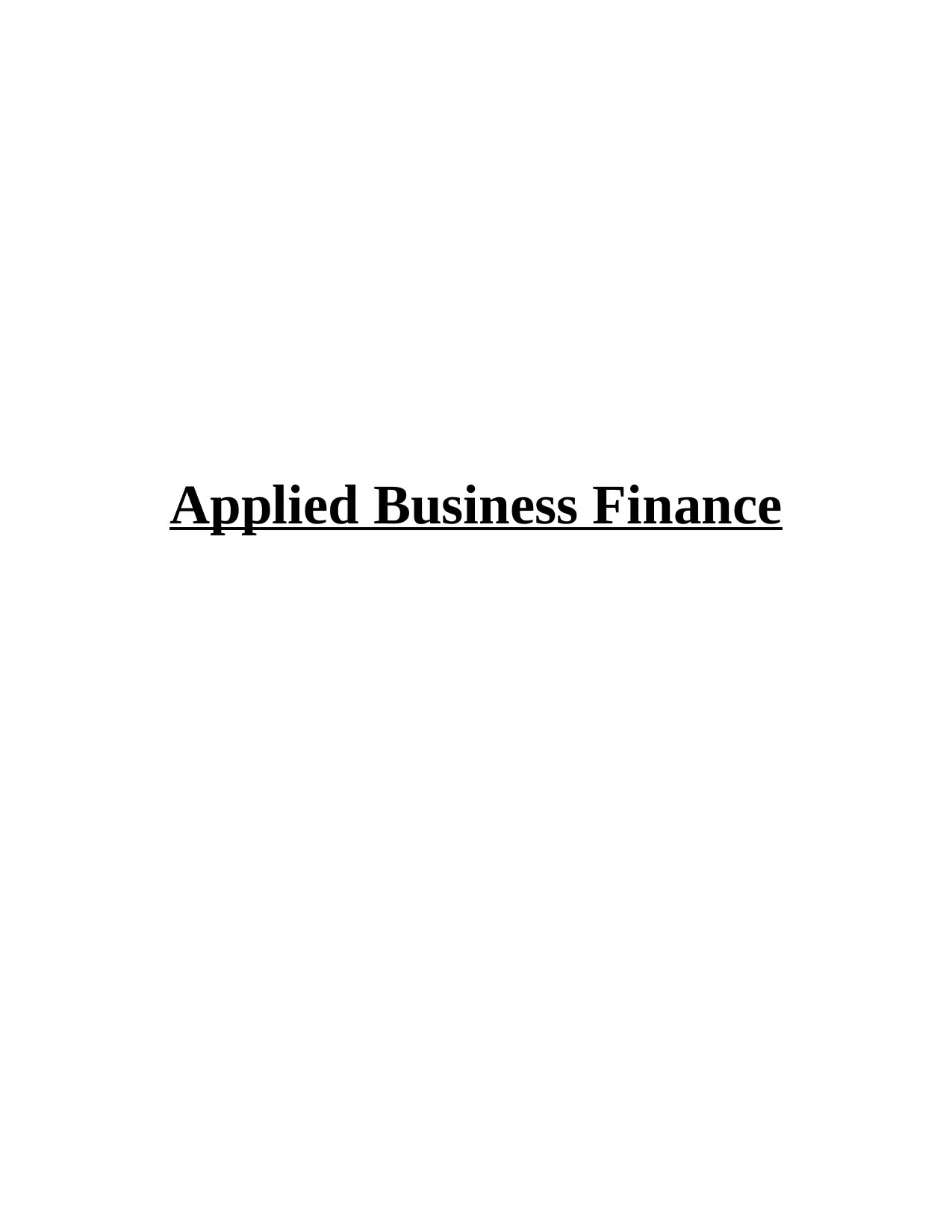
Applied Business Finance
Paraphrase This Document
Need a fresh take? Get an instant paraphrase of this document with our AI Paraphraser
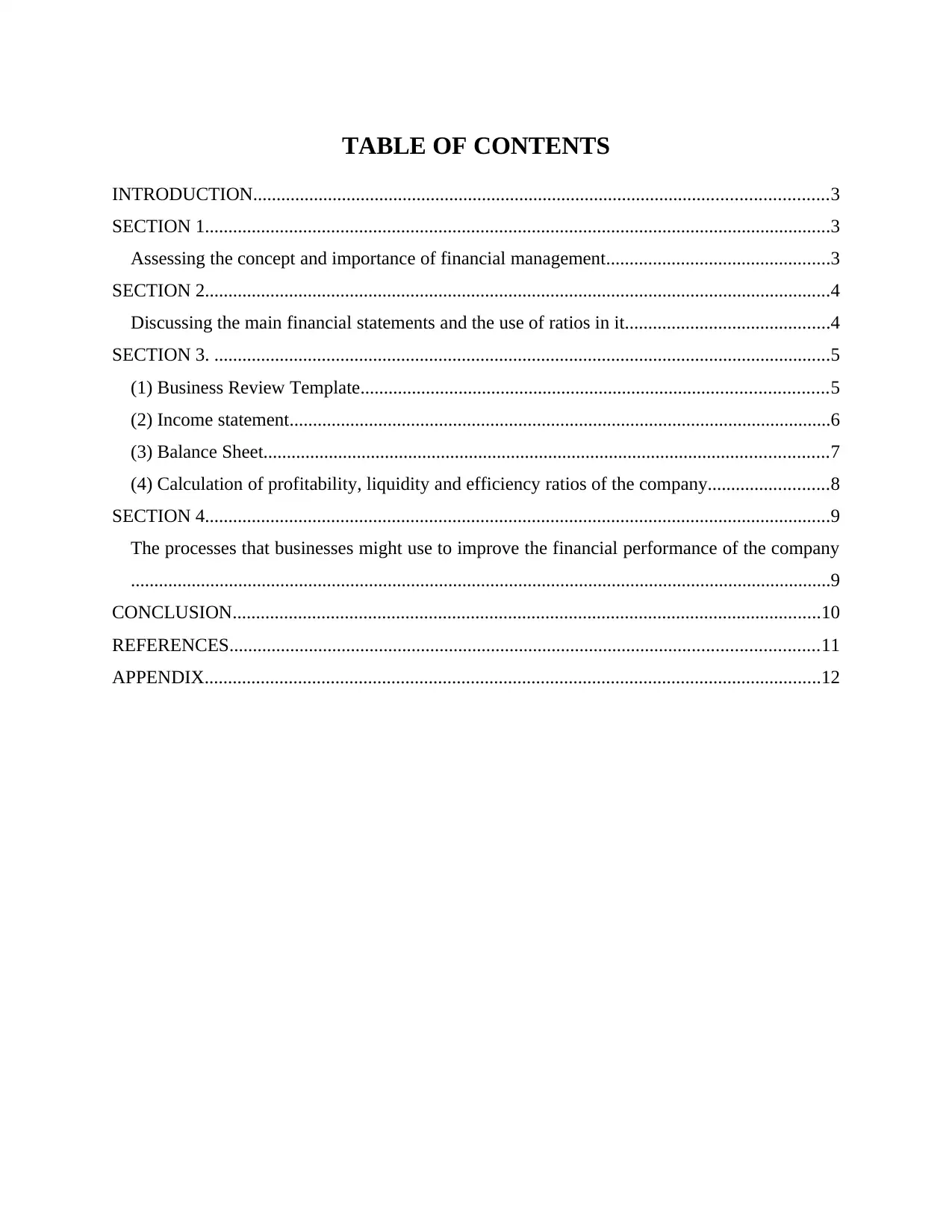
TABLE OF CONTENTS
INTRODUCTION...........................................................................................................................3
SECTION 1......................................................................................................................................3
Assessing the concept and importance of financial management................................................3
SECTION 2......................................................................................................................................4
Discussing the main financial statements and the use of ratios in it............................................4
SECTION 3. ....................................................................................................................................5
(1) Business Review Template....................................................................................................5
(2) Income statement....................................................................................................................6
(3) Balance Sheet.........................................................................................................................7
(4) Calculation of profitability, liquidity and efficiency ratios of the company..........................8
SECTION 4......................................................................................................................................9
The processes that businesses might use to improve the financial performance of the company
......................................................................................................................................................9
CONCLUSION..............................................................................................................................10
REFERENCES..............................................................................................................................11
APPENDIX....................................................................................................................................12
INTRODUCTION...........................................................................................................................3
SECTION 1......................................................................................................................................3
Assessing the concept and importance of financial management................................................3
SECTION 2......................................................................................................................................4
Discussing the main financial statements and the use of ratios in it............................................4
SECTION 3. ....................................................................................................................................5
(1) Business Review Template....................................................................................................5
(2) Income statement....................................................................................................................6
(3) Balance Sheet.........................................................................................................................7
(4) Calculation of profitability, liquidity and efficiency ratios of the company..........................8
SECTION 4......................................................................................................................................9
The processes that businesses might use to improve the financial performance of the company
......................................................................................................................................................9
CONCLUSION..............................................................................................................................10
REFERENCES..............................................................................................................................11
APPENDIX....................................................................................................................................12
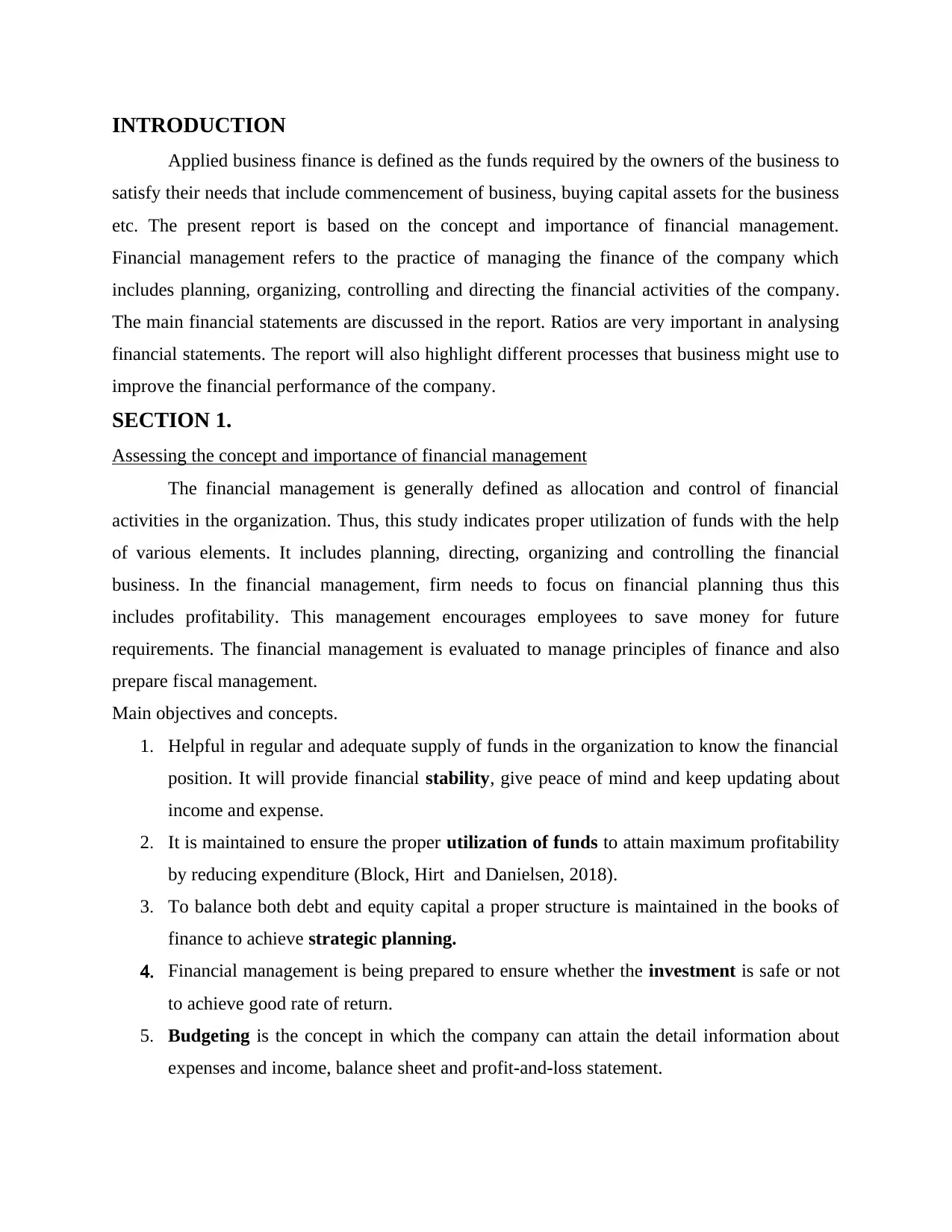
INTRODUCTION
Applied business finance is defined as the funds required by the owners of the business to
satisfy their needs that include commencement of business, buying capital assets for the business
etc. The present report is based on the concept and importance of financial management.
Financial management refers to the practice of managing the finance of the company which
includes planning, organizing, controlling and directing the financial activities of the company.
The main financial statements are discussed in the report. Ratios are very important in analysing
financial statements. The report will also highlight different processes that business might use to
improve the financial performance of the company.
SECTION 1.
Assessing the concept and importance of financial management
The financial management is generally defined as allocation and control of financial
activities in the organization. Thus, this study indicates proper utilization of funds with the help
of various elements. It includes planning, directing, organizing and controlling the financial
business. In the financial management, firm needs to focus on financial planning thus this
includes profitability. This management encourages employees to save money for future
requirements. The financial management is evaluated to manage principles of finance and also
prepare fiscal management.
Main objectives and concepts.
1. Helpful in regular and adequate supply of funds in the organization to know the financial
position. It will provide financial stability, give peace of mind and keep updating about
income and expense.
2. It is maintained to ensure the proper utilization of funds to attain maximum profitability
by reducing expenditure (Block, Hirt and Danielsen, 2018).
3. To balance both debt and equity capital a proper structure is maintained in the books of
finance to achieve strategic planning.
4. Financial management is being prepared to ensure whether the investment is safe or not
to achieve good rate of return.
5. Budgeting is the concept in which the company can attain the detail information about
expenses and income, balance sheet and profit-and-loss statement.
Applied business finance is defined as the funds required by the owners of the business to
satisfy their needs that include commencement of business, buying capital assets for the business
etc. The present report is based on the concept and importance of financial management.
Financial management refers to the practice of managing the finance of the company which
includes planning, organizing, controlling and directing the financial activities of the company.
The main financial statements are discussed in the report. Ratios are very important in analysing
financial statements. The report will also highlight different processes that business might use to
improve the financial performance of the company.
SECTION 1.
Assessing the concept and importance of financial management
The financial management is generally defined as allocation and control of financial
activities in the organization. Thus, this study indicates proper utilization of funds with the help
of various elements. It includes planning, directing, organizing and controlling the financial
business. In the financial management, firm needs to focus on financial planning thus this
includes profitability. This management encourages employees to save money for future
requirements. The financial management is evaluated to manage principles of finance and also
prepare fiscal management.
Main objectives and concepts.
1. Helpful in regular and adequate supply of funds in the organization to know the financial
position. It will provide financial stability, give peace of mind and keep updating about
income and expense.
2. It is maintained to ensure the proper utilization of funds to attain maximum profitability
by reducing expenditure (Block, Hirt and Danielsen, 2018).
3. To balance both debt and equity capital a proper structure is maintained in the books of
finance to achieve strategic planning.
4. Financial management is being prepared to ensure whether the investment is safe or not
to achieve good rate of return.
5. Budgeting is the concept in which the company can attain the detail information about
expenses and income, balance sheet and profit-and-loss statement.
⊘ This is a preview!⊘
Do you want full access?
Subscribe today to unlock all pages.

Trusted by 1+ million students worldwide
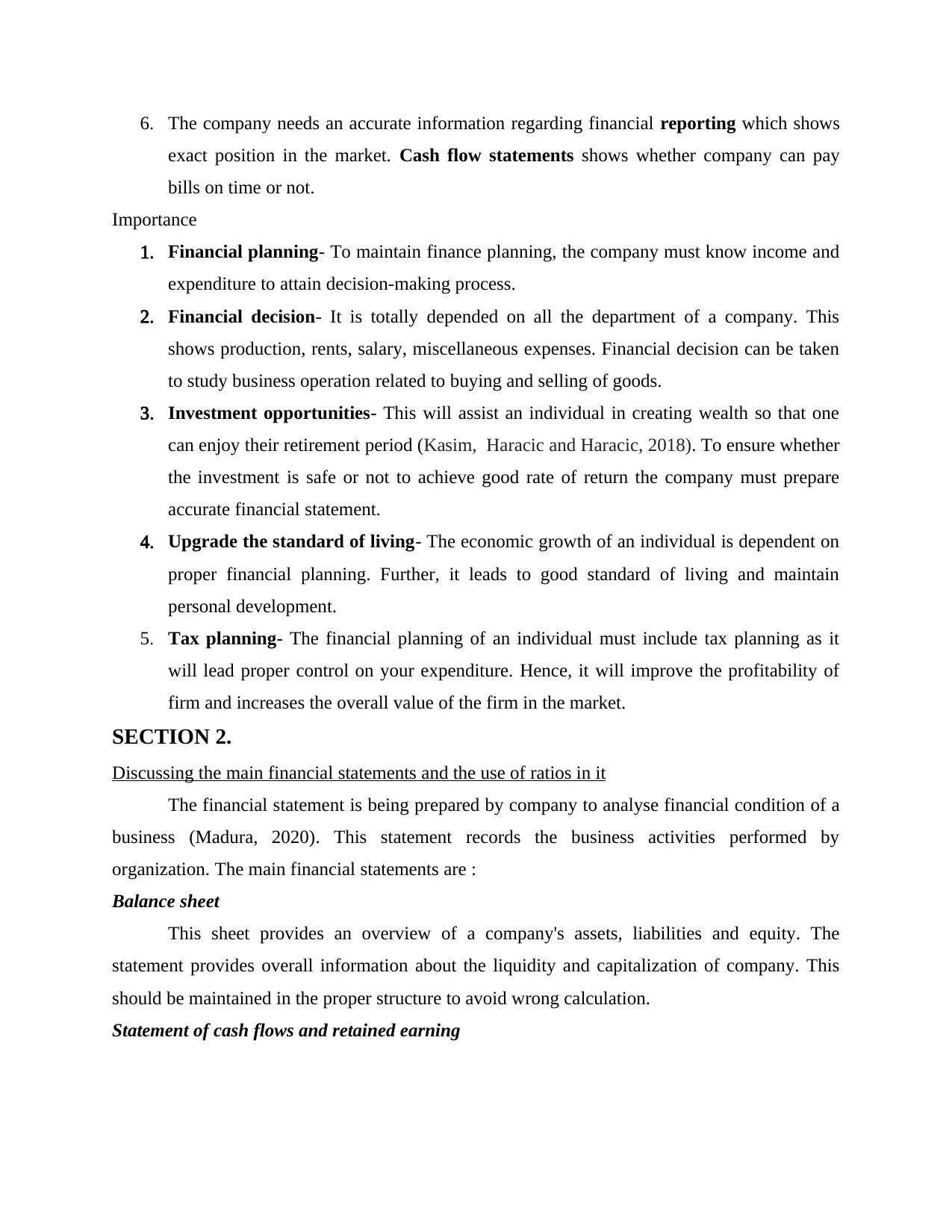
6. The company needs an accurate information regarding financial reporting which shows
exact position in the market. Cash flow statements shows whether company can pay
bills on time or not.
Importance
1. Financial planning- To maintain finance planning, the company must know income and
expenditure to attain decision-making process.
2. Financial decision- It is totally depended on all the department of a company. This
shows production, rents, salary, miscellaneous expenses. Financial decision can be taken
to study business operation related to buying and selling of goods.
3. Investment opportunities- This will assist an individual in creating wealth so that one
can enjoy their retirement period (Kasim, Haracic and Haracic, 2018). To ensure whether
the investment is safe or not to achieve good rate of return the company must prepare
accurate financial statement.
4. Upgrade the standard of living- The economic growth of an individual is dependent on
proper financial planning. Further, it leads to good standard of living and maintain
personal development.
5. Tax planning- The financial planning of an individual must include tax planning as it
will lead proper control on your expenditure. Hence, it will improve the profitability of
firm and increases the overall value of the firm in the market.
SECTION 2.
Discussing the main financial statements and the use of ratios in it
The financial statement is being prepared by company to analyse financial condition of a
business (Madura, 2020). This statement records the business activities performed by
organization. The main financial statements are :
Balance sheet
This sheet provides an overview of a company's assets, liabilities and equity. The
statement provides overall information about the liquidity and capitalization of company. This
should be maintained in the proper structure to avoid wrong calculation.
Statement of cash flows and retained earning
exact position in the market. Cash flow statements shows whether company can pay
bills on time or not.
Importance
1. Financial planning- To maintain finance planning, the company must know income and
expenditure to attain decision-making process.
2. Financial decision- It is totally depended on all the department of a company. This
shows production, rents, salary, miscellaneous expenses. Financial decision can be taken
to study business operation related to buying and selling of goods.
3. Investment opportunities- This will assist an individual in creating wealth so that one
can enjoy their retirement period (Kasim, Haracic and Haracic, 2018). To ensure whether
the investment is safe or not to achieve good rate of return the company must prepare
accurate financial statement.
4. Upgrade the standard of living- The economic growth of an individual is dependent on
proper financial planning. Further, it leads to good standard of living and maintain
personal development.
5. Tax planning- The financial planning of an individual must include tax planning as it
will lead proper control on your expenditure. Hence, it will improve the profitability of
firm and increases the overall value of the firm in the market.
SECTION 2.
Discussing the main financial statements and the use of ratios in it
The financial statement is being prepared by company to analyse financial condition of a
business (Madura, 2020). This statement records the business activities performed by
organization. The main financial statements are :
Balance sheet
This sheet provides an overview of a company's assets, liabilities and equity. The
statement provides overall information about the liquidity and capitalization of company. This
should be maintained in the proper structure to avoid wrong calculation.
Statement of cash flows and retained earning
Paraphrase This Document
Need a fresh take? Get an instant paraphrase of this document with our AI Paraphraser
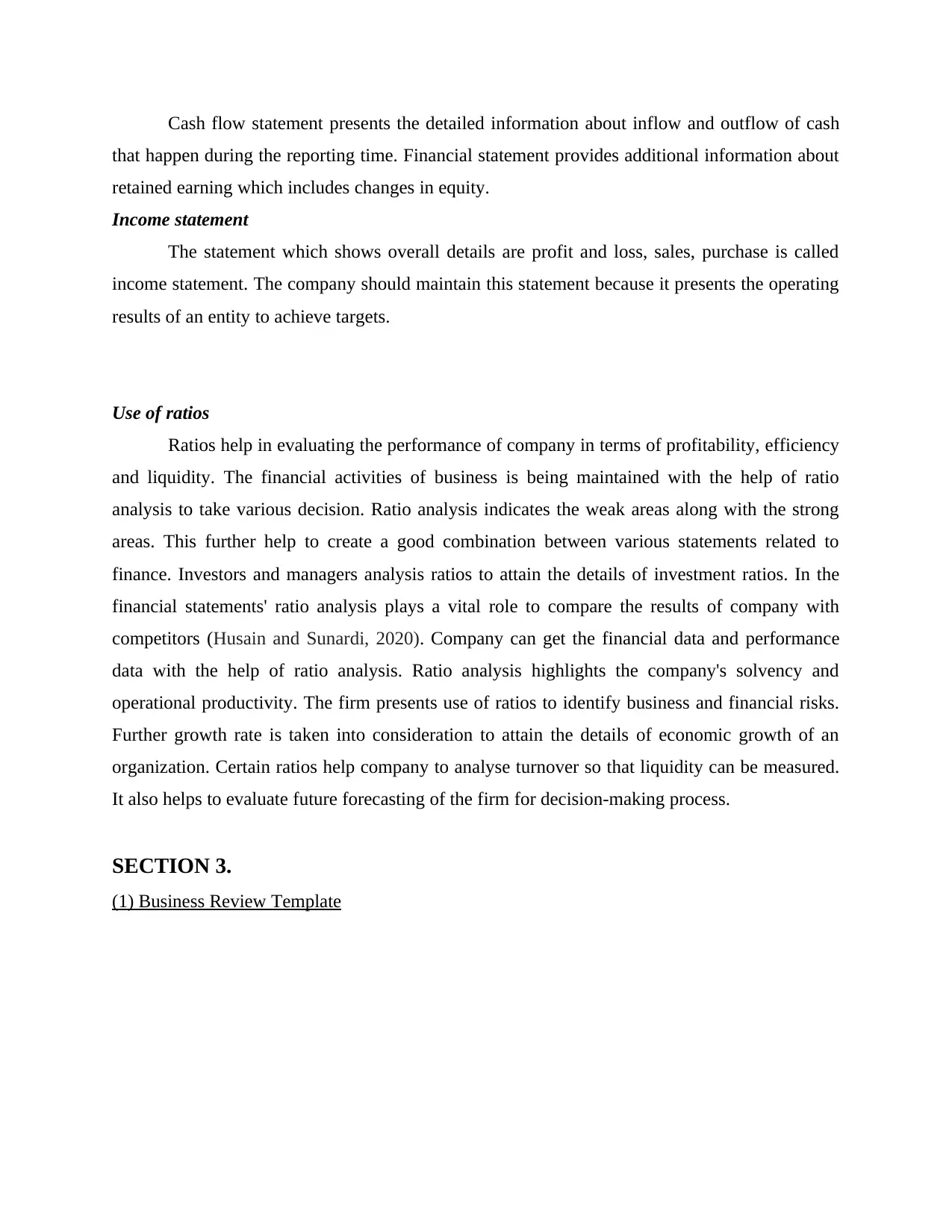
Cash flow statement presents the detailed information about inflow and outflow of cash
that happen during the reporting time. Financial statement provides additional information about
retained earning which includes changes in equity.
Income statement
The statement which shows overall details are profit and loss, sales, purchase is called
income statement. The company should maintain this statement because it presents the operating
results of an entity to achieve targets.
Use of ratios
Ratios help in evaluating the performance of company in terms of profitability, efficiency
and liquidity. The financial activities of business is being maintained with the help of ratio
analysis to take various decision. Ratio analysis indicates the weak areas along with the strong
areas. This further help to create a good combination between various statements related to
finance. Investors and managers analysis ratios to attain the details of investment ratios. In the
financial statements' ratio analysis plays a vital role to compare the results of company with
competitors (Husain and Sunardi, 2020). Company can get the financial data and performance
data with the help of ratio analysis. Ratio analysis highlights the company's solvency and
operational productivity. The firm presents use of ratios to identify business and financial risks.
Further growth rate is taken into consideration to attain the details of economic growth of an
organization. Certain ratios help company to analyse turnover so that liquidity can be measured.
It also helps to evaluate future forecasting of the firm for decision-making process.
SECTION 3.
(1) Business Review Template
that happen during the reporting time. Financial statement provides additional information about
retained earning which includes changes in equity.
Income statement
The statement which shows overall details are profit and loss, sales, purchase is called
income statement. The company should maintain this statement because it presents the operating
results of an entity to achieve targets.
Use of ratios
Ratios help in evaluating the performance of company in terms of profitability, efficiency
and liquidity. The financial activities of business is being maintained with the help of ratio
analysis to take various decision. Ratio analysis indicates the weak areas along with the strong
areas. This further help to create a good combination between various statements related to
finance. Investors and managers analysis ratios to attain the details of investment ratios. In the
financial statements' ratio analysis plays a vital role to compare the results of company with
competitors (Husain and Sunardi, 2020). Company can get the financial data and performance
data with the help of ratio analysis. Ratio analysis highlights the company's solvency and
operational productivity. The firm presents use of ratios to identify business and financial risks.
Further growth rate is taken into consideration to attain the details of economic growth of an
organization. Certain ratios help company to analyse turnover so that liquidity can be measured.
It also helps to evaluate future forecasting of the firm for decision-making process.
SECTION 3.
(1) Business Review Template
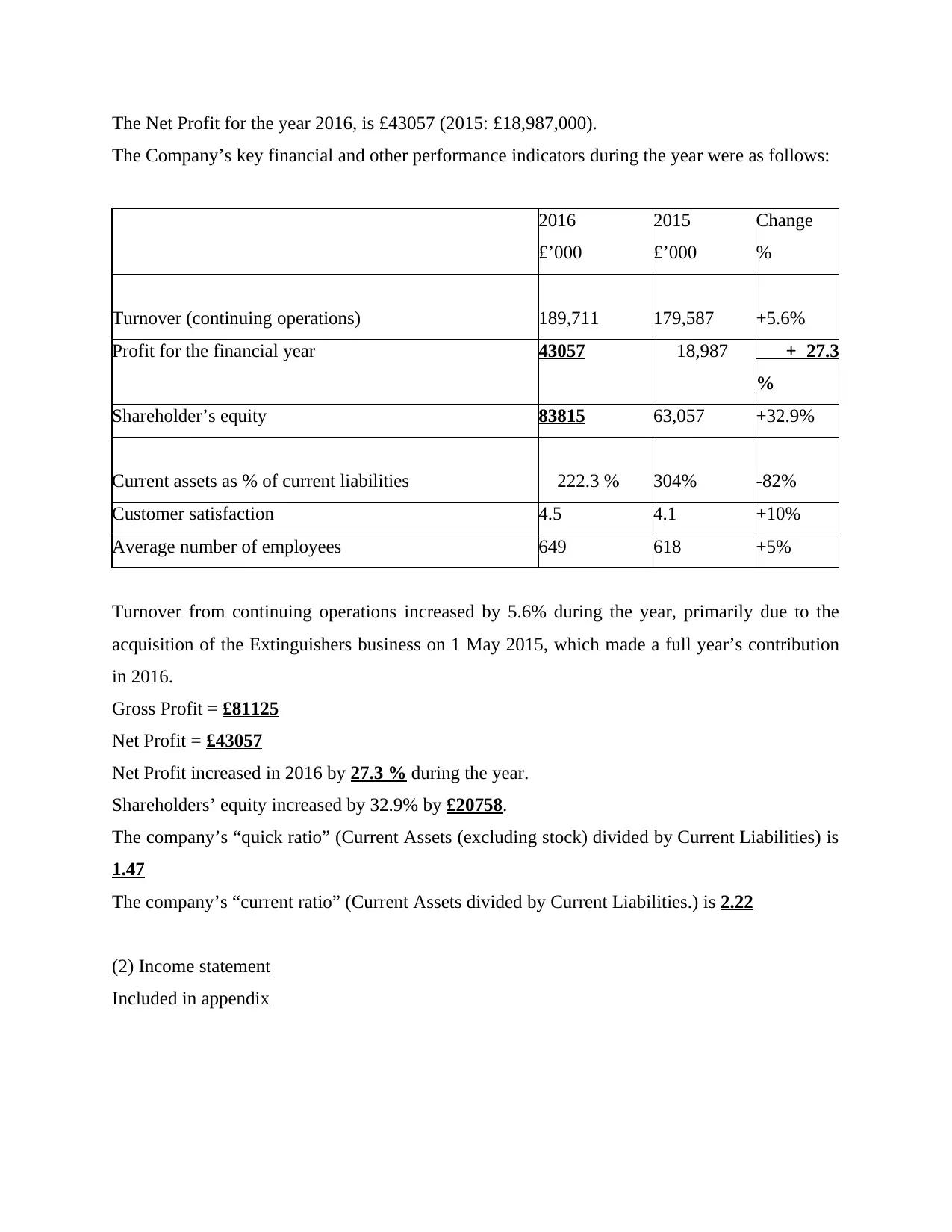
The Net Profit for the year 2016, is £43057 (2015: £18,987,000).
The Company’s key financial and other performance indicators during the year were as follows:
2016
£’000
2015
£’000
Change
%
Turnover (continuing operations) 189,711 179,587 +5.6%
Profit for the financial year 43057 18,987 + 27.3
%
Shareholder’s equity 83815 63,057 +32.9%
Current assets as % of current liabilities 222.3 % 304% -82%
Customer satisfaction 4.5 4.1 +10%
Average number of employees 649 618 +5%
Turnover from continuing operations increased by 5.6% during the year, primarily due to the
acquisition of the Extinguishers business on 1 May 2015, which made a full year’s contribution
in 2016.
Gross Profit = £81125
Net Profit = £43057
Net Profit increased in 2016 by 27.3 % during the year.
Shareholders’ equity increased by 32.9% by £20758.
The company’s “quick ratio” (Current Assets (excluding stock) divided by Current Liabilities) is
1.47
The company’s “current ratio” (Current Assets divided by Current Liabilities.) is 2.22
(2) Income statement
Included in appendix
The Company’s key financial and other performance indicators during the year were as follows:
2016
£’000
2015
£’000
Change
%
Turnover (continuing operations) 189,711 179,587 +5.6%
Profit for the financial year 43057 18,987 + 27.3
%
Shareholder’s equity 83815 63,057 +32.9%
Current assets as % of current liabilities 222.3 % 304% -82%
Customer satisfaction 4.5 4.1 +10%
Average number of employees 649 618 +5%
Turnover from continuing operations increased by 5.6% during the year, primarily due to the
acquisition of the Extinguishers business on 1 May 2015, which made a full year’s contribution
in 2016.
Gross Profit = £81125
Net Profit = £43057
Net Profit increased in 2016 by 27.3 % during the year.
Shareholders’ equity increased by 32.9% by £20758.
The company’s “quick ratio” (Current Assets (excluding stock) divided by Current Liabilities) is
1.47
The company’s “current ratio” (Current Assets divided by Current Liabilities.) is 2.22
(2) Income statement
Included in appendix
⊘ This is a preview!⊘
Do you want full access?
Subscribe today to unlock all pages.

Trusted by 1+ million students worldwide
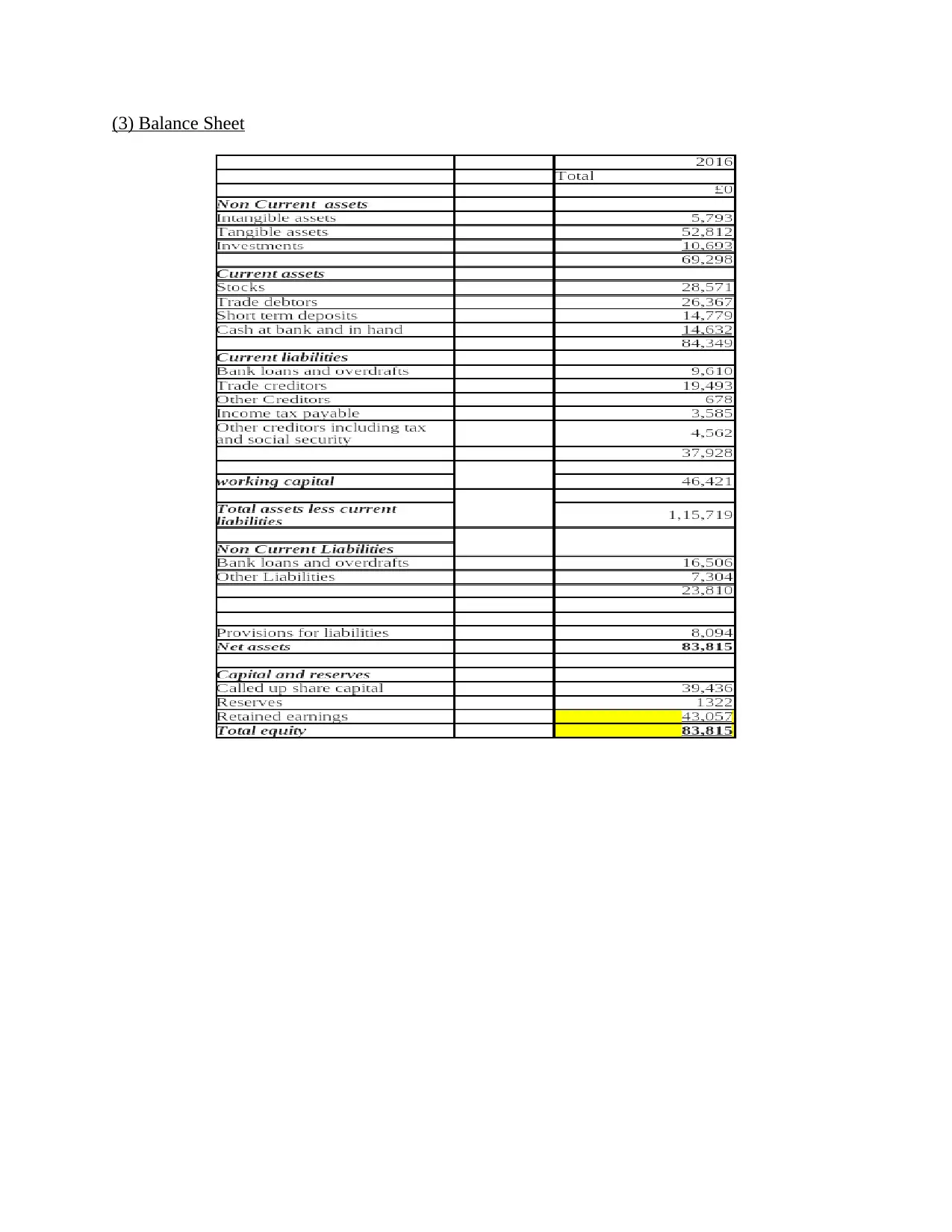
(3) Balance Sheet
Paraphrase This Document
Need a fresh take? Get an instant paraphrase of this document with our AI Paraphraser
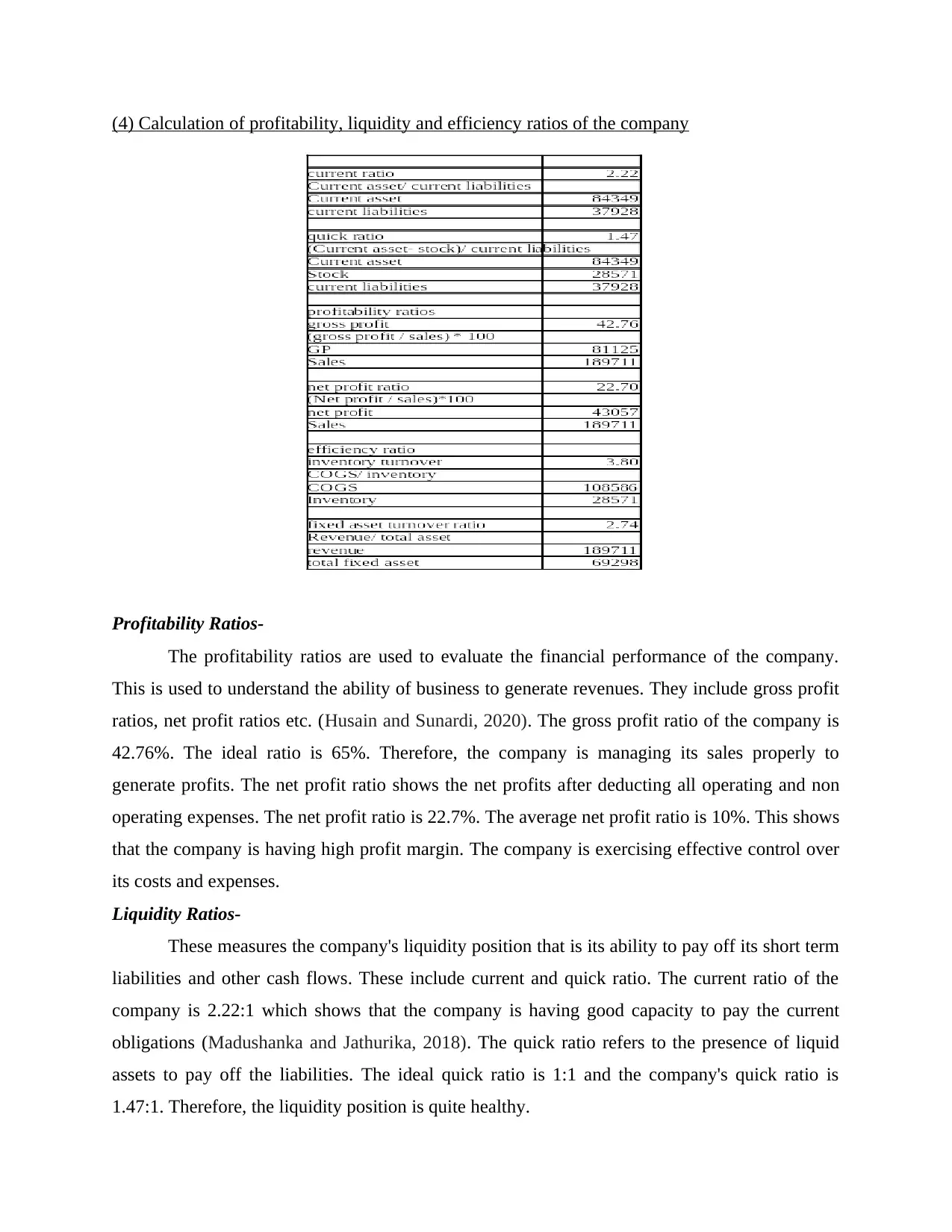
(4) Calculation of profitability, liquidity and efficiency ratios of the company
Profitability Ratios-
The profitability ratios are used to evaluate the financial performance of the company.
This is used to understand the ability of business to generate revenues. They include gross profit
ratios, net profit ratios etc. (Husain and Sunardi, 2020). The gross profit ratio of the company is
42.76%. The ideal ratio is 65%. Therefore, the company is managing its sales properly to
generate profits. The net profit ratio shows the net profits after deducting all operating and non
operating expenses. The net profit ratio is 22.7%. The average net profit ratio is 10%. This shows
that the company is having high profit margin. The company is exercising effective control over
its costs and expenses.
Liquidity Ratios-
These measures the company's liquidity position that is its ability to pay off its short term
liabilities and other cash flows. These include current and quick ratio. The current ratio of the
company is 2.22:1 which shows that the company is having good capacity to pay the current
obligations (Madushanka and Jathurika, 2018). The quick ratio refers to the presence of liquid
assets to pay off the liabilities. The ideal quick ratio is 1:1 and the company's quick ratio is
1.47:1. Therefore, the liquidity position is quite healthy.
Profitability Ratios-
The profitability ratios are used to evaluate the financial performance of the company.
This is used to understand the ability of business to generate revenues. They include gross profit
ratios, net profit ratios etc. (Husain and Sunardi, 2020). The gross profit ratio of the company is
42.76%. The ideal ratio is 65%. Therefore, the company is managing its sales properly to
generate profits. The net profit ratio shows the net profits after deducting all operating and non
operating expenses. The net profit ratio is 22.7%. The average net profit ratio is 10%. This shows
that the company is having high profit margin. The company is exercising effective control over
its costs and expenses.
Liquidity Ratios-
These measures the company's liquidity position that is its ability to pay off its short term
liabilities and other cash flows. These include current and quick ratio. The current ratio of the
company is 2.22:1 which shows that the company is having good capacity to pay the current
obligations (Madushanka and Jathurika, 2018). The quick ratio refers to the presence of liquid
assets to pay off the liabilities. The ideal quick ratio is 1:1 and the company's quick ratio is
1.47:1. Therefore, the liquidity position is quite healthy.
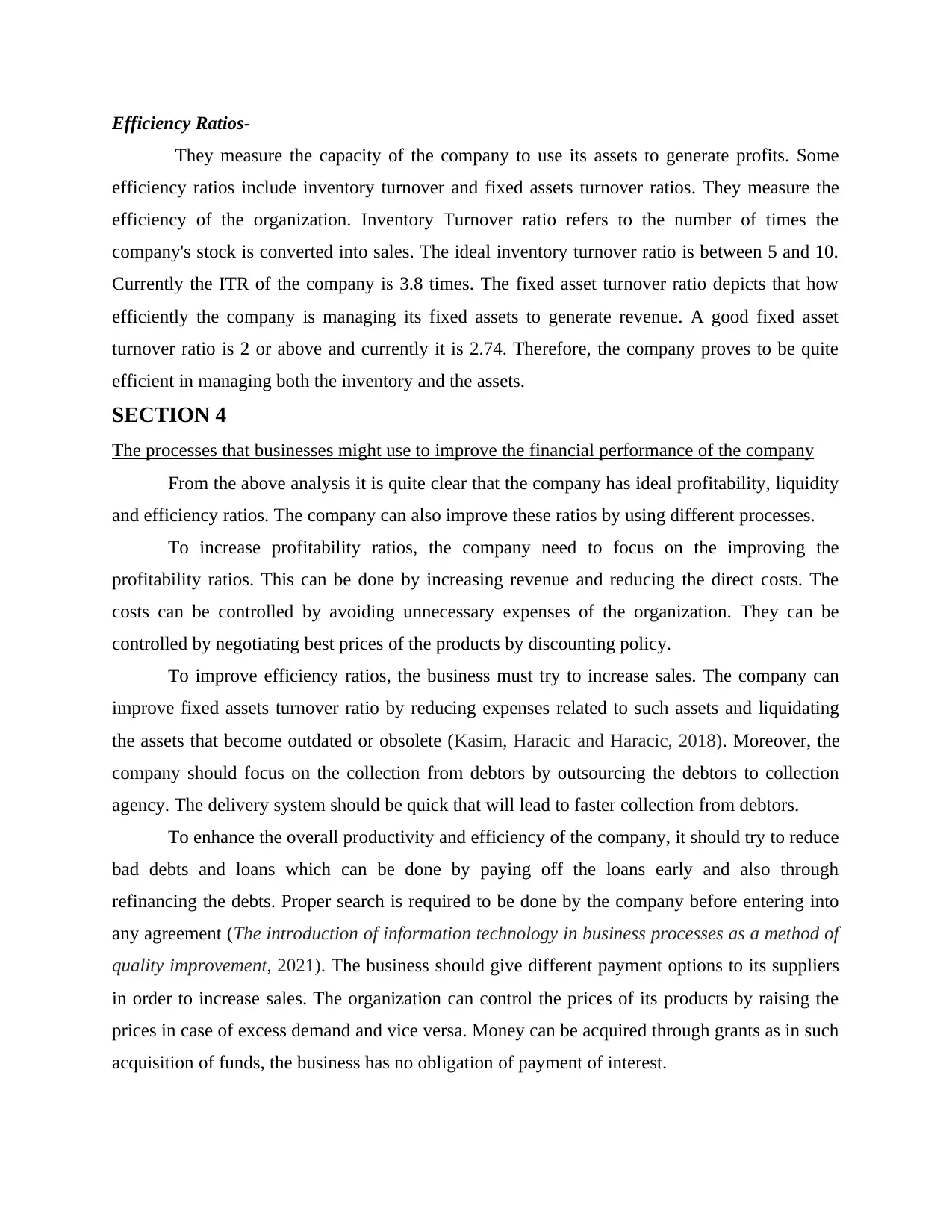
Efficiency Ratios-
They measure the capacity of the company to use its assets to generate profits. Some
efficiency ratios include inventory turnover and fixed assets turnover ratios. They measure the
efficiency of the organization. Inventory Turnover ratio refers to the number of times the
company's stock is converted into sales. The ideal inventory turnover ratio is between 5 and 10.
Currently the ITR of the company is 3.8 times. The fixed asset turnover ratio depicts that how
efficiently the company is managing its fixed assets to generate revenue. A good fixed asset
turnover ratio is 2 or above and currently it is 2.74. Therefore, the company proves to be quite
efficient in managing both the inventory and the assets.
SECTION 4
The processes that businesses might use to improve the financial performance of the company
From the above analysis it is quite clear that the company has ideal profitability, liquidity
and efficiency ratios. The company can also improve these ratios by using different processes.
To increase profitability ratios, the company need to focus on the improving the
profitability ratios. This can be done by increasing revenue and reducing the direct costs. The
costs can be controlled by avoiding unnecessary expenses of the organization. They can be
controlled by negotiating best prices of the products by discounting policy.
To improve efficiency ratios, the business must try to increase sales. The company can
improve fixed assets turnover ratio by reducing expenses related to such assets and liquidating
the assets that become outdated or obsolete (Kasim, Haracic and Haracic, 2018). Moreover, the
company should focus on the collection from debtors by outsourcing the debtors to collection
agency. The delivery system should be quick that will lead to faster collection from debtors.
To enhance the overall productivity and efficiency of the company, it should try to reduce
bad debts and loans which can be done by paying off the loans early and also through
refinancing the debts. Proper search is required to be done by the company before entering into
any agreement (The introduction of information technology in business processes as a method of
quality improvement, 2021). The business should give different payment options to its suppliers
in order to increase sales. The organization can control the prices of its products by raising the
prices in case of excess demand and vice versa. Money can be acquired through grants as in such
acquisition of funds, the business has no obligation of payment of interest.
They measure the capacity of the company to use its assets to generate profits. Some
efficiency ratios include inventory turnover and fixed assets turnover ratios. They measure the
efficiency of the organization. Inventory Turnover ratio refers to the number of times the
company's stock is converted into sales. The ideal inventory turnover ratio is between 5 and 10.
Currently the ITR of the company is 3.8 times. The fixed asset turnover ratio depicts that how
efficiently the company is managing its fixed assets to generate revenue. A good fixed asset
turnover ratio is 2 or above and currently it is 2.74. Therefore, the company proves to be quite
efficient in managing both the inventory and the assets.
SECTION 4
The processes that businesses might use to improve the financial performance of the company
From the above analysis it is quite clear that the company has ideal profitability, liquidity
and efficiency ratios. The company can also improve these ratios by using different processes.
To increase profitability ratios, the company need to focus on the improving the
profitability ratios. This can be done by increasing revenue and reducing the direct costs. The
costs can be controlled by avoiding unnecessary expenses of the organization. They can be
controlled by negotiating best prices of the products by discounting policy.
To improve efficiency ratios, the business must try to increase sales. The company can
improve fixed assets turnover ratio by reducing expenses related to such assets and liquidating
the assets that become outdated or obsolete (Kasim, Haracic and Haracic, 2018). Moreover, the
company should focus on the collection from debtors by outsourcing the debtors to collection
agency. The delivery system should be quick that will lead to faster collection from debtors.
To enhance the overall productivity and efficiency of the company, it should try to reduce
bad debts and loans which can be done by paying off the loans early and also through
refinancing the debts. Proper search is required to be done by the company before entering into
any agreement (The introduction of information technology in business processes as a method of
quality improvement, 2021). The business should give different payment options to its suppliers
in order to increase sales. The organization can control the prices of its products by raising the
prices in case of excess demand and vice versa. Money can be acquired through grants as in such
acquisition of funds, the business has no obligation of payment of interest.
⊘ This is a preview!⊘
Do you want full access?
Subscribe today to unlock all pages.

Trusted by 1+ million students worldwide
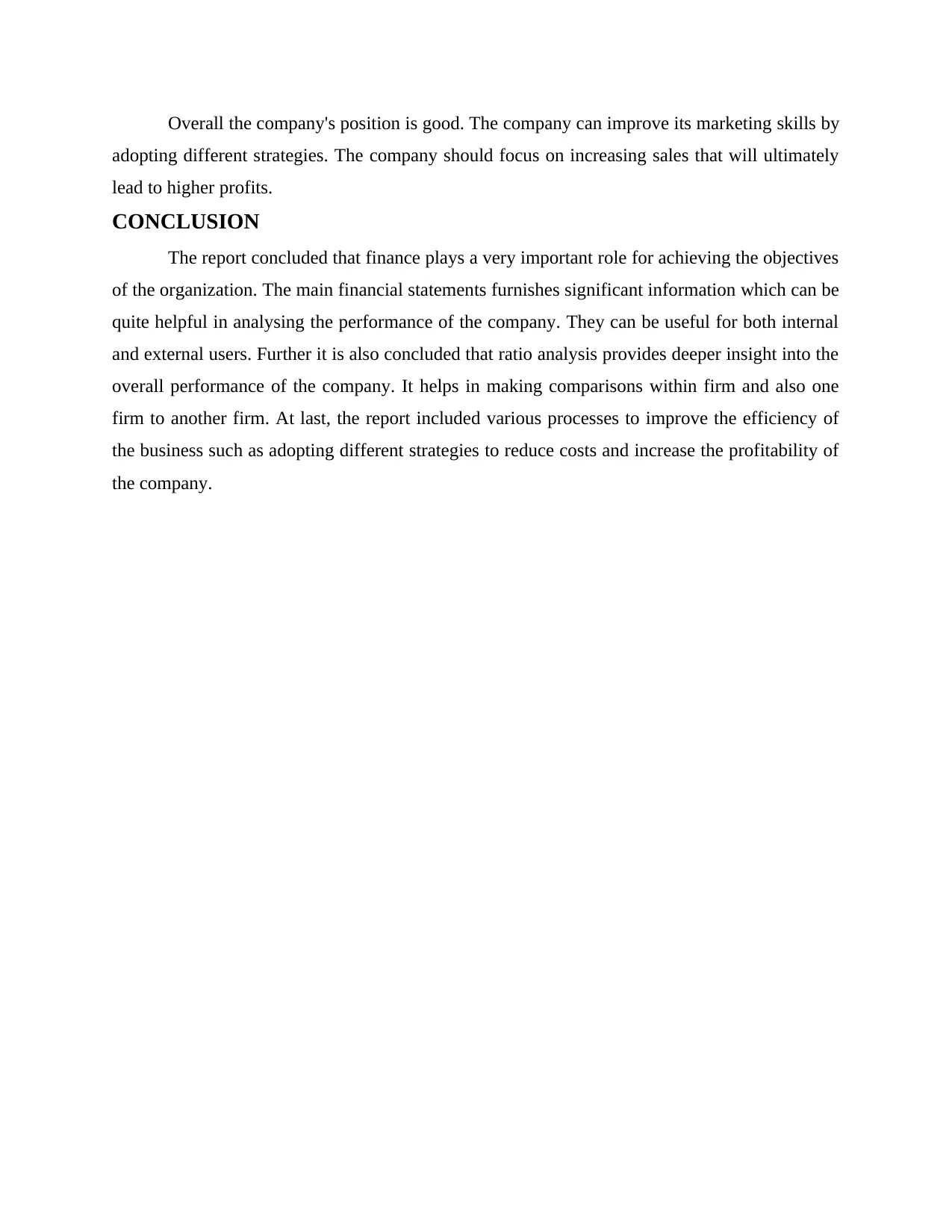
Overall the company's position is good. The company can improve its marketing skills by
adopting different strategies. The company should focus on increasing sales that will ultimately
lead to higher profits.
CONCLUSION
The report concluded that finance plays a very important role for achieving the objectives
of the organization. The main financial statements furnishes significant information which can be
quite helpful in analysing the performance of the company. They can be useful for both internal
and external users. Further it is also concluded that ratio analysis provides deeper insight into the
overall performance of the company. It helps in making comparisons within firm and also one
firm to another firm. At last, the report included various processes to improve the efficiency of
the business such as adopting different strategies to reduce costs and increase the profitability of
the company.
adopting different strategies. The company should focus on increasing sales that will ultimately
lead to higher profits.
CONCLUSION
The report concluded that finance plays a very important role for achieving the objectives
of the organization. The main financial statements furnishes significant information which can be
quite helpful in analysing the performance of the company. They can be useful for both internal
and external users. Further it is also concluded that ratio analysis provides deeper insight into the
overall performance of the company. It helps in making comparisons within firm and also one
firm to another firm. At last, the report included various processes to improve the efficiency of
the business such as adopting different strategies to reduce costs and increase the profitability of
the company.
Paraphrase This Document
Need a fresh take? Get an instant paraphrase of this document with our AI Paraphraser

REFERENCES
Books and Journal
Block, S. B., Hirt, G. A. and Danielsen, B.R., 2018. Foundations of financial management.
McGraw-Hill Education.
Husain, T. and Sunardi, N., 2020. Firm's Value Prediction Based on Profitability Ratios and
Dividend Policy. Finance & Economics Review.2(2).pp.13-26.
Kasim, T., Haracic, M. and Haracic, M., 2018. The improvement of business efficiency through
business process management. Economic Review: Journal of Economics and Business. 16(1).
pp.31-43.
Madura, J., 2020. International financial management. Cengage Learning.
Madushanka, K. H. I. and Jathurika, M., 2018. The impact of liquidity ratios on
profitability. International Research Journal of Advanced Engineering and Science. 3(4).
pp.157-161.
Siminica, M., Motoi, A. G. and Dumitru, A., 2017. Financial management as component of
tactical management. Polish Journal of Management Studies. 15.
Yap, R. J. C., Komalasari, F. and Hadiansah, I., 2018. The effect of financial literacy and attitude
on financial management behavior and satisfaction. BISNIS & BIROKRASI: Journal Ilmu
Administrasi dan Organisasi. 23(3). p.4.
Chandra, P., 2020. Fundamentals of Financial Management|. McGraw-Hill Education
Online
The introduction of information technology in business processes as a method of quality
improvement, 2021. [Online]. Available through<https://iopscience.iop.org/article/10.1088/1757-
899X/666/1/012059/meta>
Books and Journal
Block, S. B., Hirt, G. A. and Danielsen, B.R., 2018. Foundations of financial management.
McGraw-Hill Education.
Husain, T. and Sunardi, N., 2020. Firm's Value Prediction Based on Profitability Ratios and
Dividend Policy. Finance & Economics Review.2(2).pp.13-26.
Kasim, T., Haracic, M. and Haracic, M., 2018. The improvement of business efficiency through
business process management. Economic Review: Journal of Economics and Business. 16(1).
pp.31-43.
Madura, J., 2020. International financial management. Cengage Learning.
Madushanka, K. H. I. and Jathurika, M., 2018. The impact of liquidity ratios on
profitability. International Research Journal of Advanced Engineering and Science. 3(4).
pp.157-161.
Siminica, M., Motoi, A. G. and Dumitru, A., 2017. Financial management as component of
tactical management. Polish Journal of Management Studies. 15.
Yap, R. J. C., Komalasari, F. and Hadiansah, I., 2018. The effect of financial literacy and attitude
on financial management behavior and satisfaction. BISNIS & BIROKRASI: Journal Ilmu
Administrasi dan Organisasi. 23(3). p.4.
Chandra, P., 2020. Fundamentals of Financial Management|. McGraw-Hill Education
Online
The introduction of information technology in business processes as a method of quality
improvement, 2021. [Online]. Available through<https://iopscience.iop.org/article/10.1088/1757-
899X/666/1/012059/meta>
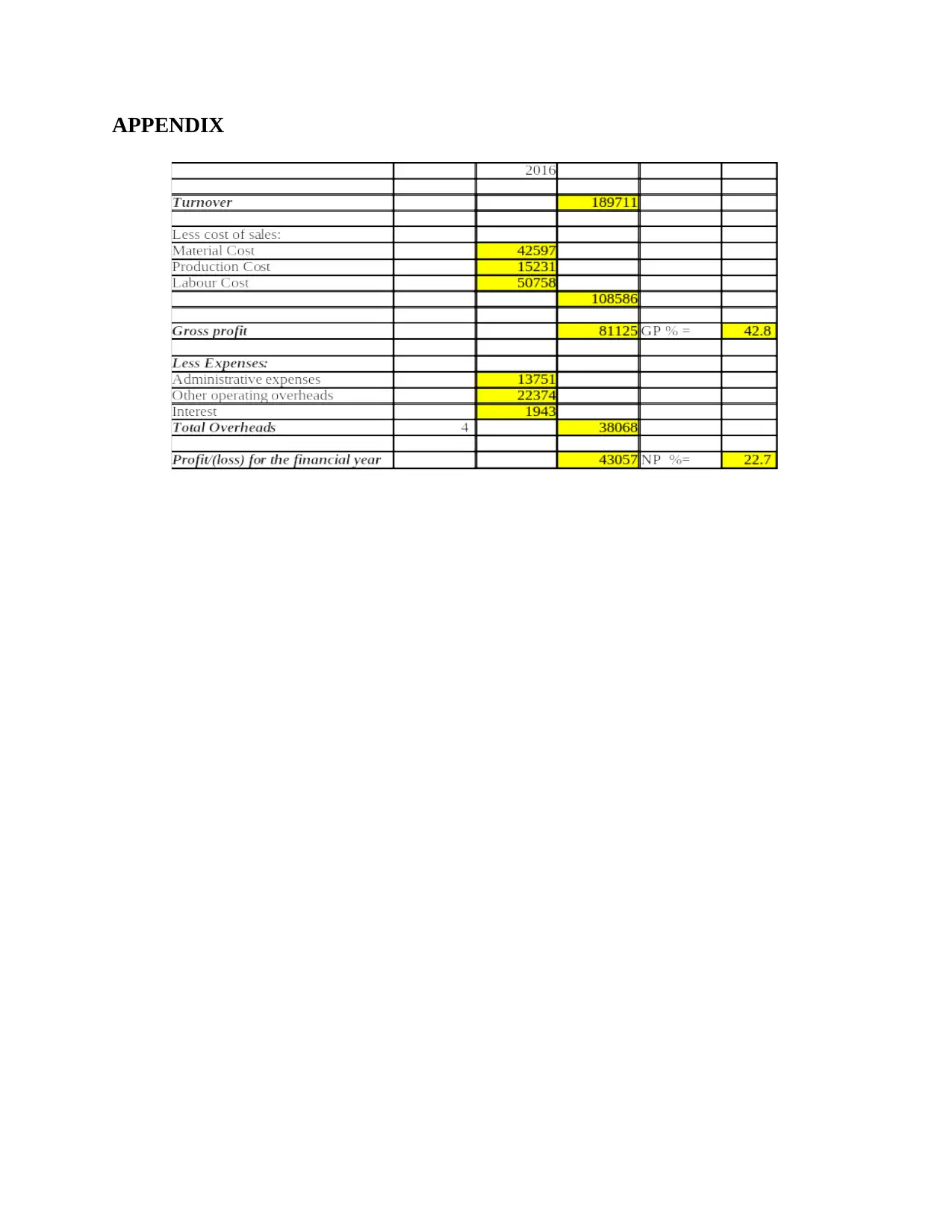
APPENDIX
⊘ This is a preview!⊘
Do you want full access?
Subscribe today to unlock all pages.

Trusted by 1+ million students worldwide
1 out of 15
Related Documents
Your All-in-One AI-Powered Toolkit for Academic Success.
+13062052269
info@desklib.com
Available 24*7 on WhatsApp / Email
![[object Object]](/_next/static/media/star-bottom.7253800d.svg)
Unlock your academic potential
Copyright © 2020–2025 A2Z Services. All Rights Reserved. Developed and managed by ZUCOL.




